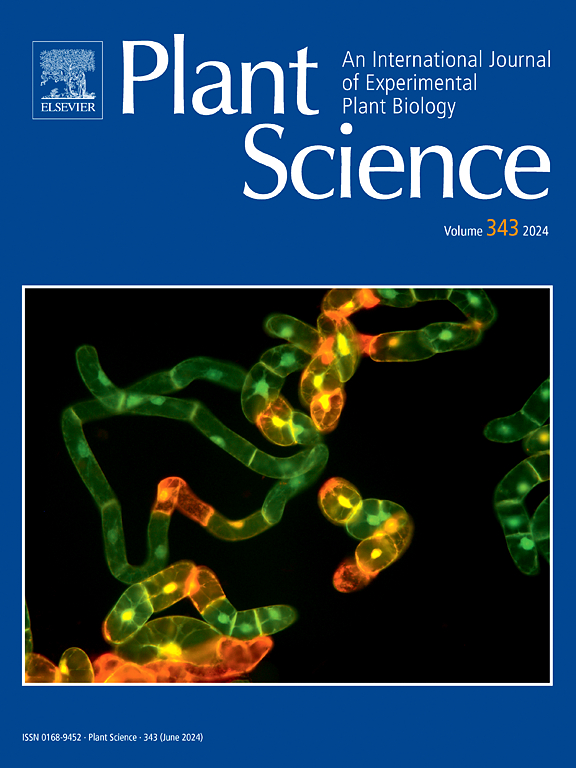H2O2-generating polyamine oxidases (PAOs) are modulated during sweet pepper ripening: Spermine oxidase (SpmOX) as a case study of post-translational modification regulation
IF 4.2
2区 生物学
Q2 BIOCHEMISTRY & MOLECULAR BIOLOGY
引用次数: 0
Abstract
Polyamine oxidases (PAOs) are flavin-containing enzymes involved in the catabolism of polyamines through the oxidative deamination of spermine (Spm) and spermidine (Spd). Transcriptome analysis of pepper (Capsicum annuum) fruit revealed six PAO genes (CaPAO1 to CaPAO6) expressed during ripening. Time-course expression profiling across three developmental stages, green immature (G), breaking point (BP), and red ripe (R), showed differential regulation: CaPAO5 and CaPAO6 were upregulated during ripening, while CaPAO1 and CaPAO3 were downregulated. CaPAO4 expression remained relatively stable. Exposure to exogenous nitric oxide (NO) gas induced upregulation of CaPAO1 to CaPAO3 and downregulation of CaPAO4 and CaPAO6, with CaPAO5 unaffected. Non-denaturing PAGE assays identified four PAO isozymes (CaSpmOX and CaSpdOX I–IV), using Spm or Spd as substrates. CaSpmOX IV and CaSpdOX IV exhibited the highest activities, while CaSpmOX III and CaSpdOX III were progressively inhibited during ripening, with CaSpdOX III showing complete inhibition at the red stage. To assess the influence of signaling molecules, in vitro assays were performed using green fruit extracts treated with nitric oxide (NO) donors (GSNO, CysNO), peroxynitrite (SIN-1), hydrogen sulfide (H2S) donor (NaHS), hydrogen peroxide, and reducing agents (GSH, L-cysteine). CaSpmOX III emerged as the most sensitive isozyme, displaying 85–100 % inhibition under these treatments. This suggests susceptibility to post-translational modifications (PTMs) such as nitration, S-nitrosation, and persulfidation. Overall, these results demonstrate that H2O2-producing CaPAOs are tightly regulated at both the gene and activity levels during fruit ripening, and that NO and H2S contribute to their modulation, integrating them into the broader redox and signaling network of ripening pepper fruit.
生成h2o2的多胺氧化酶(PAOs)在甜椒成熟过程中受到调控:以精胺氧化酶(SpmOX)为例进行了翻译后修饰调控研究
多胺氧化酶(PAOs)是一种含黄素的酶,通过对精胺(Spm)和亚精胺(Spd)的氧化脱胺,参与多胺的分解代谢。对辣椒果实进行转录组分析,发现6个PAO基因(CaPAO1 ~ CaPAO6)在果实成熟过程中表达。绿色未成熟(G)、断裂点(BP)和红色成熟(R)三个发育阶段的时间序列表达谱显示出差异调控:CaPAO5和CaPAO6在成熟过程中上调,而CaPAO1和CaPAO3则下调。CaPAO4表达保持相对稳定。暴露于外源性一氧化氮(NO)气体诱导CaPAO1对CaPAO3表达上调,CaPAO4和CaPAO6表达下调,而CaPAO5不受影响。非变性PAGE检测鉴定出四种PAO同工酶(CaSpmOX和CaSpdOX I-IV),使用Spm或Spd作为底物。CaSpmOX IV和CaSpdOX IV的活性最高,而CaSpmOX III和CaSpdOX III在成熟过程中被逐渐抑制,CaSpdOX III在红色阶段被完全抑制。为了评估信号分子的影响,体外实验采用用一氧化氮(NO)供体(GSNO、CysNO)、过氧亚硝酸盐(SIN-1)、硫化氢(H2S)供体(NaHS)、过氧化氢和还原剂(GSH、l -半胱氨酸)处理的青果提取物进行。CaSpmOX III是最敏感的同工酶,在这些处理下表现出85-100 %的抑制作用。这表明对翻译后修饰(PTMs)的易感性,如硝化,s -亚硝化和过硫化。总的来说,这些结果表明,在果实成熟过程中,产生h2o2的CaPAOs在基因和活性水平上都受到严格调控,而NO和H2S参与了它们的调控,将它们整合到成熟辣椒果实的更广泛的氧化还原和信号网络中。
本文章由计算机程序翻译,如有差异,请以英文原文为准。
求助全文
约1分钟内获得全文
求助全文
来源期刊

Plant Science
生物-生化与分子生物学
CiteScore
9.10
自引率
1.90%
发文量
322
审稿时长
33 days
期刊介绍:
Plant Science will publish in the minimum of time, research manuscripts as well as commissioned reviews and commentaries recommended by its referees in all areas of experimental plant biology with emphasis in the broad areas of genomics, proteomics, biochemistry (including enzymology), physiology, cell biology, development, genetics, functional plant breeding, systems biology and the interaction of plants with the environment.
Manuscripts for full consideration should be written concisely and essentially as a final report. The main criterion for publication is that the manuscript must contain original and significant insights that lead to a better understanding of fundamental plant biology. Papers centering on plant cell culture should be of interest to a wide audience and methods employed result in a substantial improvement over existing established techniques and approaches. Methods papers are welcome only when the technique(s) described is novel or provides a major advancement of established protocols.
 求助内容:
求助内容: 应助结果提醒方式:
应助结果提醒方式:


